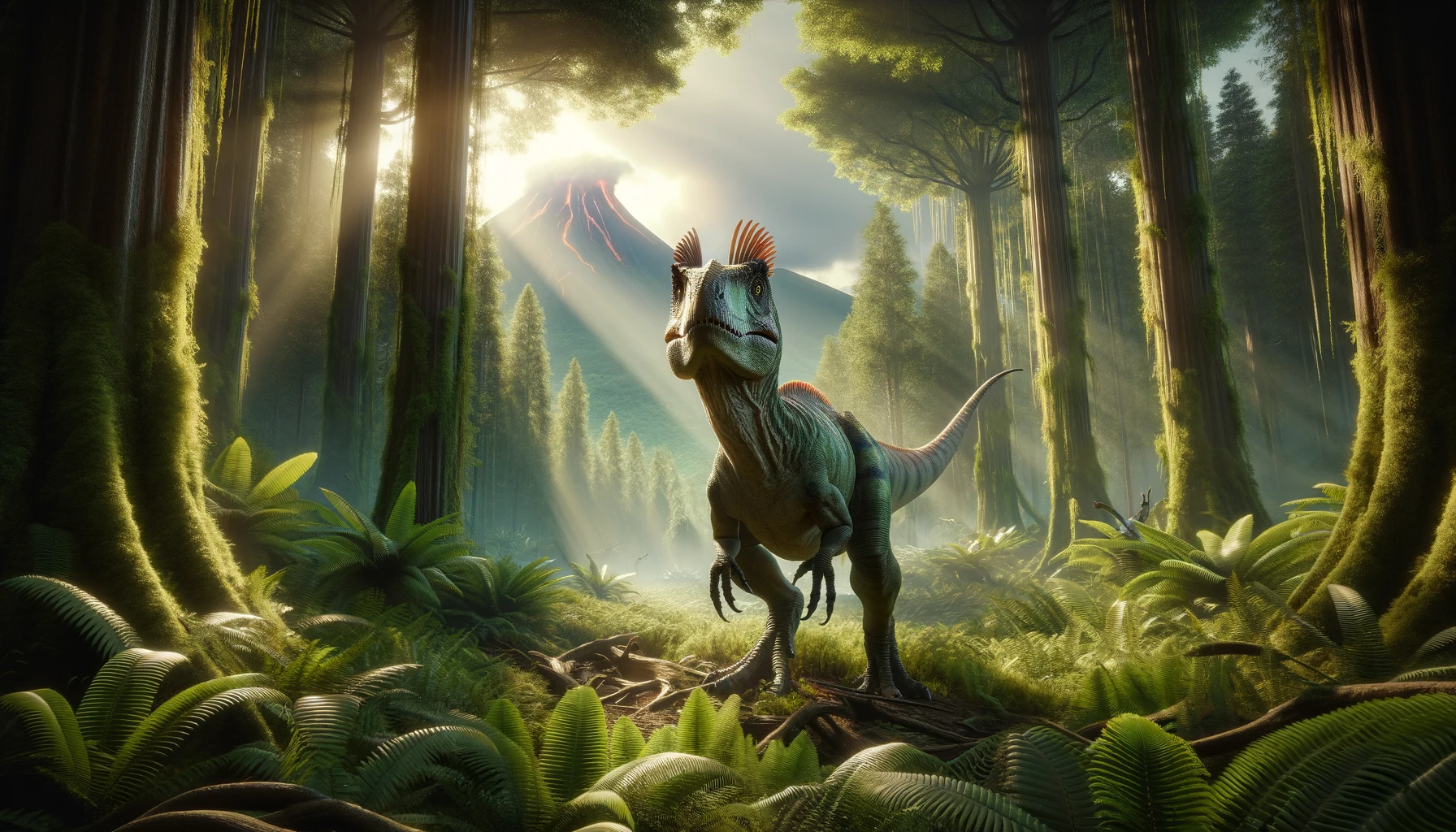Emerging straight from the pages of a science fiction narrative, the mesmerizing creature that possesses the ability to spit acid certainly earns its distinguished spot in the annals of prehistoric life. This prompts the intriguing question: Which Dinosaur Spits Acid?
Embarking on an exploratory journey into the world of this extraordinary dinosaur, we delve deep into its dietary habits and the remarkable mechanism behind its acid spit. This exploration not only sheds light on its unique adaptations but also highlights its significance in the prehistoric ecosystem.
In essence, understanding the acid-spitting dinosaur involves examining its feeding patterns, which, in turn, provides insight into the development of its most notorious defense mechanism. The synthesis of these aspects paints a comprehensive picture of its existence and underscores its indelible mark on history.

The Dilophosaurus is thought to have spit acid as a way to kill its prey.
What dinosaur spits acid?
In the fascinating world of prehistoric creatures, the Dilophosaurus stands out not only for its distinctive physical features but also for its unique defensive capabilities. This leads us to ponder: What dinosaur spits acid?
The Dilophosaurus, most recognizable by the twin crests adorning its head, has intrigued scientists and enthusiasts alike. These crests are believed to have played a crucial role in either display rituals or as a means of defense, adding a layer of mystery to this already intriguing dinosaur.
Moreover, the Dilophosaurus is celebrated for its remarkable ability to spit acid, a characteristic that likely served as a formidable deterrent against would-be predators. This acid-spitting trait underscores the Dilophosaurus’s place in the prehistoric ecosystem as a creature not only equipped with physical adornments for display but also endowed with an effective defense mechanism to protect itself in a world where survival was a constant challenge.
How acid might have protected the Dilophosaurus from predators

In the realm of prehistoric marvels, the Dilophosaurus presents an intriguing case of evolutionary adaptation. A focal point of interest centers on understanding how acid might have protected the Dilophosaurus from predators, shedding light on the survival strategies of this ancient creature.
The Dilophosaurus, a diminutive yet formidable presence in the Early Jurassic landscape, walked on two legs and was classified among the smaller dinosaurs of its time. Despite its size, it was a predator to be reckoned with, hunting down lizards and small mammals with proficiency. This hunting prowess, coupled with its unique defense mechanisms, highlights the Dilophosaurus’s role in the ecosystem of its era.
Through exploring the potential use of acid as a protective measure, we gain insights into the evolutionary traits that allowed the Dilophosaurus to thrive amidst the challenges of its environment. The blend of agility, predatory skill, and possibly chemical defense mechanisms paints a comprehensive picture of how the Dilophosaurus navigated the perilous world of the Early Jurassic period.
One of the most distinctive features of the Dilophosaurus was the presence of acid in its saliva.
- Scientists believe that this acid might have helped protect the Dilophosaurus from predators, as it would have made the animal’s bite more painful and difficult to heal.
- In addition, the acid might have also helped to break down the prey’s bones, making it easier for the Dilophosaurus to digest its food.
Thus, the presence of acid in the Dilophosaurus’s saliva likely had several benefits for this prehistoric animal
Dilophosaurus diet and why it spit acid

Exploring the dietary habits of the Dilophosaurus reveals fascinating insights into its survival strategies during the Early Jurassic period. The intriguing aspect of Dilophosaurus diet and why it spit acid is a topic that captures the imagination of both scientists and enthusiasts alike.
Paleontological studies have sparked discussions regarding the precise nature of the Dilophosaurus’s diet. Evidence from fossil records suggests a carnivorous lifestyle, with the Dilophosaurus preying on smaller dinosaurs and various other creatures. This predation strategy places it squarely within the category of formidable hunters of its time.
The debate extends to the possibility of the Dilophosaurus being an opportunistic scavenger, feasting on the remains of larger dinosaurs. This adaptability in dietary habits underscores the versatility of the Dilophosaurus in securing sustenance.
A closer examination of the Dilophosaurus’s dental anatomy offers additional clues. Its sharp, serrated teeth, characteristic of theropods, were perfectly adapted for tearing flesh, supporting the theory of a primarily carnivorous diet. Yet, the observable wear on its teeth suggests a diet that may have also included tougher material, such as plants and carrion, indicating a more omnivorous feeding behavior.
A notable defensive behavior of the Dilophosaurus, possibly linked to its dietary practices, was its ability to spit acidic venom when confronted by threats. This behavior not only highlights its defensive mechanisms but also raises questions about the evolutionary advantages such capabilities provided, whether in deterring predators or in subduing prey.
In sum, the diet of the Dilophosaurus, coupled with its unique acid-spitting defense, paints a picture of a versatile and adaptive dinosaur capable of thriving in the diverse ecosystems of the Early Jurassic period.
Features of the dinosaur that spits acid and how it lived

Delving into the prehistoric era, the Dilophosaurus emerges as a fascinating subject for study, particularly for its acid-spitting behavior. This feature highlights the unique adaptations and lifestyle of the dinosaur that spits acid and how it lived during the Early Jurassic period.
The Dilophosaurus, a relatively small but agile predator, commanded attention not only for its size, at approximately 20 feet in length, but also for its status as one of the period’s most daunting predators. Among its most notable physical attributes were the twin crests adorning its head, which may have served a dual purpose in intimidation tactics against other dinosaurs and as a display to potential mates.
In addition to its striking appearance, the Dilophosaurus was equipped with formidable sharp claws and teeth, enhancing its reputation as a skilled hunter. Its ability to spit acid is particularly intriguing, suggesting an evolutionary adaptation that allowed it to target and subdue larger prey, a testament to its ingenuity in survival and hunting strategies.
Beyond its predatory skills, the Dilophosaurus exhibited remarkable athleticism, particularly in its ability to run long distances. Its anatomical structure, including long hind legs and a flexible spine, facilitated this endurance, enabling the Dilophosaurus to excel in open-terrain pursuits of its prey. This combination of speed, agility, and unique defensive mechanisms underscores the Dilophosaurus’s versatility as both a hunter and a survivor in the diverse ecosystems of the Early Jurassic period.
How did the Dilophosaurus defend itself?
The Dilophosaurus, a predator that roamed the earth during the early Jurassic period, presents a fascinating study in prehistoric survival and defense mechanisms. This examination leads us to explore: How did the Dilophosaurus defend itself?
While the precise dimensions of the Dilophosaurus remain a subject of scientific speculation, it is estimated to have reached lengths of about 20 feet and weighed around 1,000 pounds. This bipedal dinosaur featured a long neck and tail, complemented by a comparatively small head adorned with sharp teeth and two distinctive crests, which contributed to its unique appearance.
Contrary to popular depictions, there is no concrete scientific evidence to suggest that the Dilophosaurus employed spitting toxic venom as a defense strategy. This myth, while widespread, lacks factual backing within the paleontological community.
Nonetheless, the Dilophosaurus possessed several anatomical features that likely played crucial roles in its survival. Notably, its eyes were situated on the sides of its head, providing an expansive field of peripheral vision. This visual advantage would have been invaluable in detecting threats and navigating its environment.
Additionally, the Dilophosaurus’s hollow bone structure conferred upon it a significant agility advantage, making it lighter and more nimble compared to other dinosaurs of similar stature. This combination of speed and maneuverability suggests that the Dilophosaurus was adept at either evading predators or engaging them with agility-based tactics.
Though the notion of venom-spitting has been debunked, it’s theorized that if such a defense mechanism had existed, it would have produced a toxin potent enough to paralyze or kill smaller animals. Against larger adversaries, like the Tyrannosaurus Rex, the hypothetical venom would likely have caused mere irritation or discomfort, rather than fatal outcomes.
In summation, the Dilophosaurus’s defense mechanisms, characterized by its remarkable agility and strategic use of vision, underscore its adaptability and success as a dominant species during the Early Jurassic epoch.

